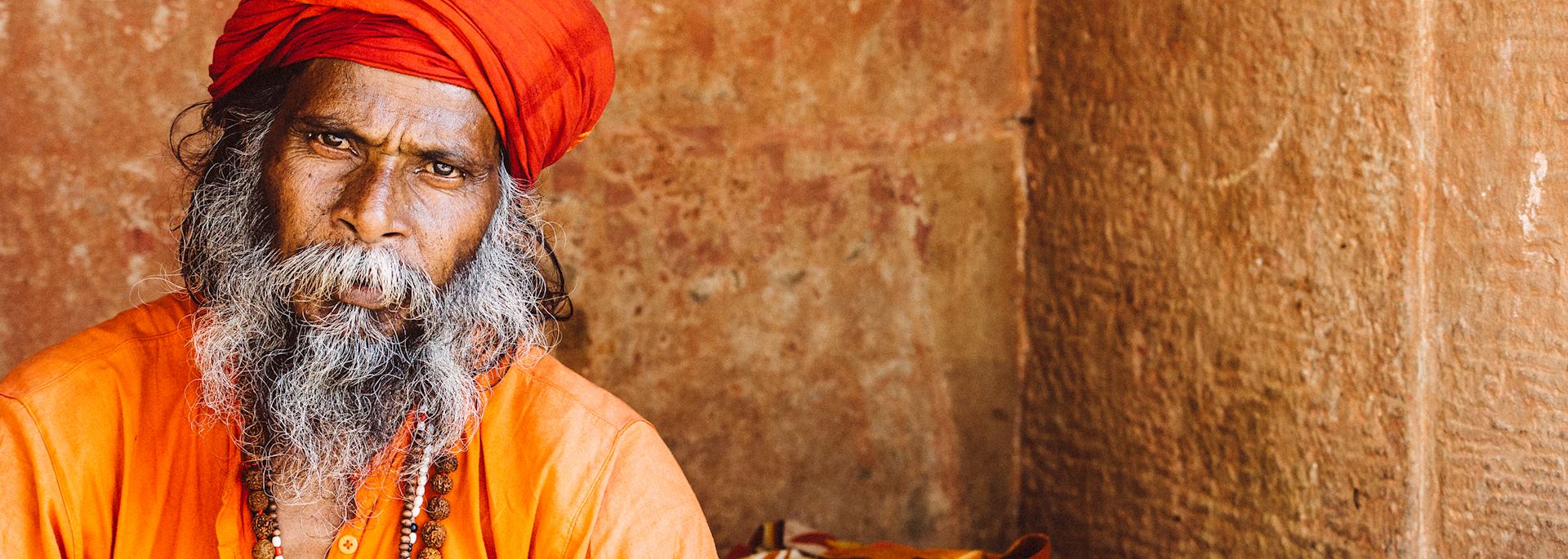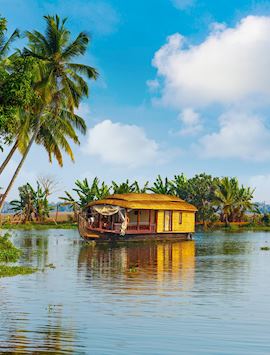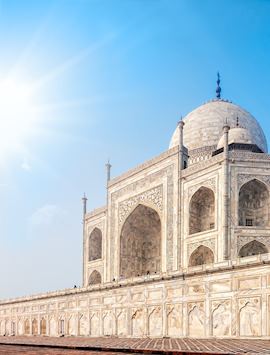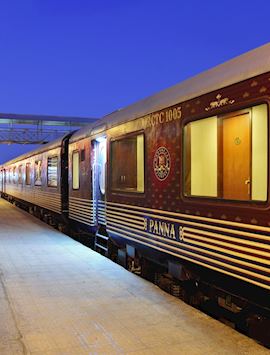You’d need a lifetime to explore every facet of India, but these suggestions from some of our most experienced Indophiles will help you choose the right Indian experience for you.
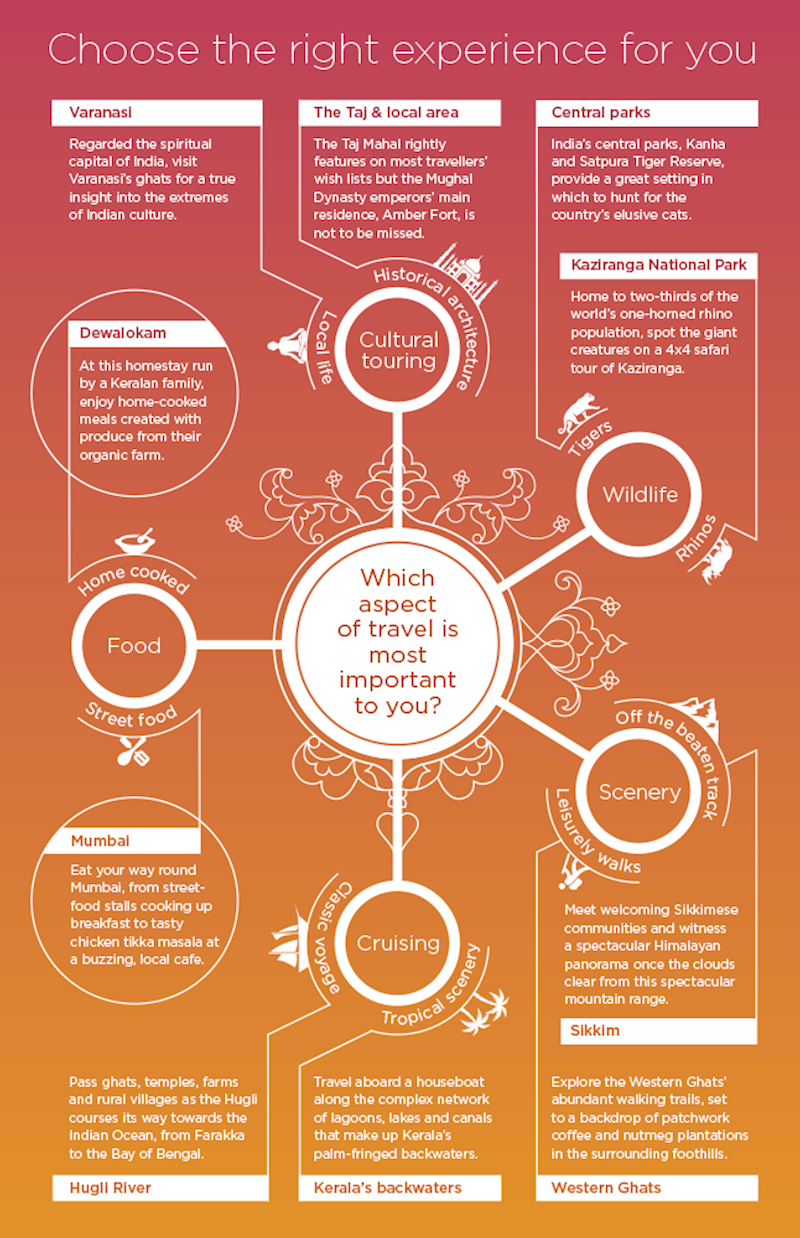
Cultural experiences in India
For architecture: The Taj and her sister sights by Andy
Yes, you should see the Taj Mahal. And, yes, it doesn’t disappoint. The thing that always gets me is the indescribable shade of marble it’s built from: with the changing sun the mausoleum can glitter white, glow yellow, then turn rose-gold as the day ends. It’s an architectural marvel, but one of many crammed into this corner of India.
My first glimpse of the Taj came from the thick red-sandstone walls of Agra Fort. I stood on the battlements, peering at the domed tomb poking out of the mist in the distance.

The fort is one of the best examples of Mughal architecture, whose intricate sandstone carvings look like they were completed yesterday. Nearby is the Tomb of I'timād-ud-Daulah, (nicknamed the Baby Taj) the first marble mausoleum built in India and inspiration for the architects of the Taj.
Long before the Taj was conceived, Mughal Emperor Babur built a series of parks on the Yamuna River’s east bank. It’s thought that Shah Jahan, the Taj’s creator, looked across the river from Metah Bagh, one of the parks, and chose the location for his wife’s mausoleum. The park has been restored and the view from the entrance gate, which is perfectly aligned with the Taj’s garden, is quite special.
For an insight into India’s people: Varanasi by Sophie
As a major religious gathering place, Varanasi has been a cultural hub for several thousand years. At times I’ve found the number of people congregated in the city, and the intensity of their worship, overwhelming. But spend a few nights here and you gain an insight into India that’s hard to get anywhere else.

Take an evening boat ride past the Ghats and you see thousands of glittering oil lamps lighting the steps down into the Ganges, ready for the evening Aarti ceremony, a ritual that dispels the darkness. I suggest you arrange for a local guide to accompany you, who can explain what you’re seeing and the importance of the ceremony which holds a deep symbolic value. It’s worth returning at sunrise the next morning, when everyone returns to the river to perform a morning puja, a ceremony to bless and purify.
Away from the river, on a walking tour you can see the sides of Varanasi most visitors pass by. Inhabitants welcome you into their homes for glasses of milky chai (tea), you discover gardens and hidden temples you’d never find otherwise, and you get to peek into everyday scenes such as (a highlight for me) men practicing kushti, traditional wrestling, inside an akhada (gym).
Wildlife
For chasing tigers: The central parks by Sophie
India may be full of people, but they’re concentrated near the coast or toward the north. The central plains remain relatively undeveloped, the preserve of farming communities. A series of national parks have established in the area, enabling wildlife to flourish.
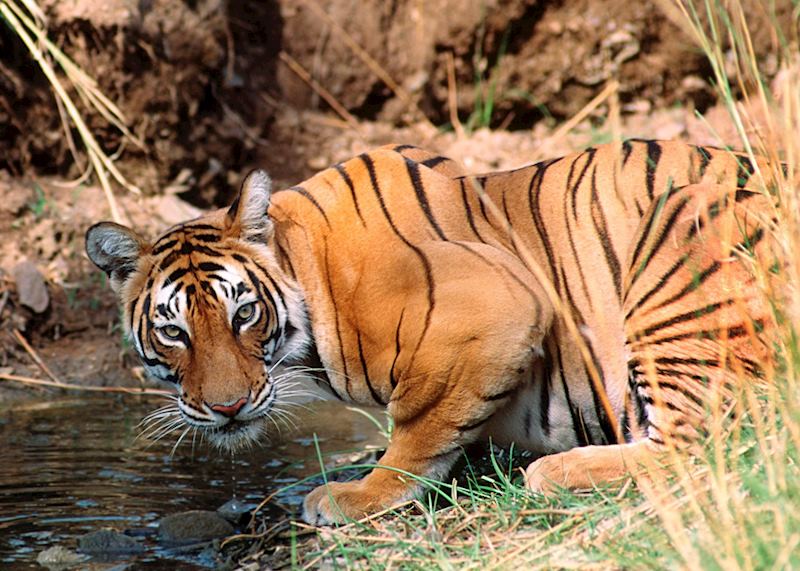
In an area you can spend weeks, even months, exploring, I suggest focusing on Kanha Tiger Reserve, one of India’s oldest parks, and the little-known Satpura Tiger Reserve. Kanha’s forests shelter herds of spotted deer and gaur (wild cow), while open meadows host jackals and wild dogs. Tigers roam in-between and, while sightings aren’t guaranteed, there’s no better place to search.
Kanha operates purely by jeep safaris, but in Satpura you can take a boat out along the creek or walk with a tracker. Tiger sightings are less frequent, but the flipside is spying a sloth bear or leopard. In terms of birdlife, I spotted the rare Indian skimmer with its distinctive orange beak, and tawny eagle sightings are common.
For a remote experience: Kaziranga National Park, Assam by Andy
The northeastern state of Assam encompasses a section of the Brahmaputra River and its tributaries, with Bangladesh closing in to the west, Myanmar to the southeast. The region is geographically and culturally segregated from the rest of India: it’s its own country albeit under an Indian flag.
Skimming along the lower bank of the Brahmaputra as it slices through the top of Assam, Kaziranga National Park and its wildlife have been left to their own devices (although poaching is now a problem). Few visitors take the domestic flight from Calcutta to get here, and those that do travel by road.
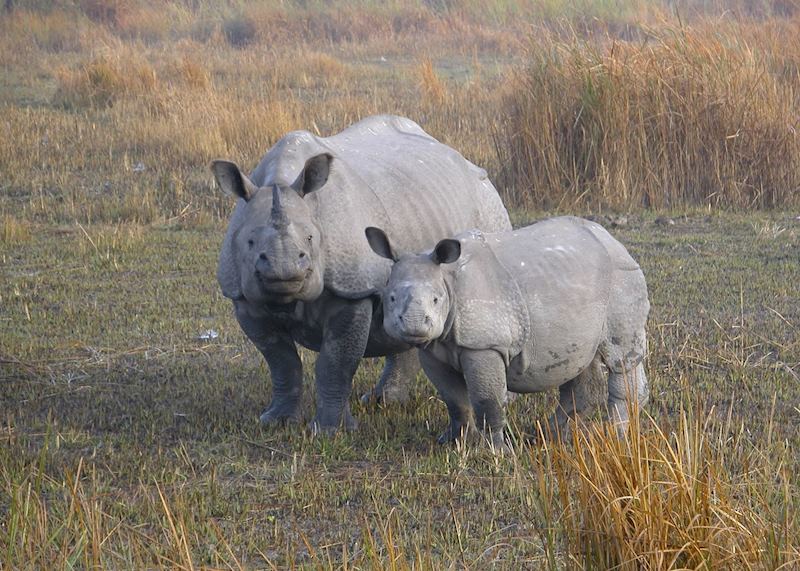
The park is a mixture of elephant grass, marshland and broadleaf forests, which shelter two-thirds of the world’s one-horned rhino population. These aren’t subtle creatures, and you see them everywhere. There are also a number of elephant herds as well as deer, lizards and a kaleidoscope of migratory birds.
Touring the park by 4x4, we stopped to watch a family of glossy-coated otters laze on the riverbank, a few turtles swimming idly by. My guide stiffened and motioned for us to look at the bushes on the opposite bank. An adult female Bengal tiger slowly emerged and padded straight into the river. We watched her swim gracefully off into the distance, following the bright of her orange head bobbing above the water. While tiger sightings definitely aren’t guaranteed, the low numbers of 4x4s in the park do increase your odds.
Diphlu River Lodge lies in the buffer zone of the park, offering a comfortable stay in traditional stilted bungalows (it’s good enough for the Duke and Duchess of Cambridge). In-between safaris you can take a guided walk through a local village, home to the Mishing tribe. The women still weave on huge wooden hand looms, and they were shy but eager to show me their work.
Mountain scenery
For dramatic mountain vistas: Sikkim by Andy
The thumb-shaped kingdom of Sikkim is almost entirely hilly, with an elevation ranging from 280 m (920 ft) to 8,586 m (28,169 ft). The world’s third-highest peak, Kangchenjunga, sits proudly at its border with Nepal. There are mural-filled monasteries and welcoming Sikkimese communities to visit, but for me, the best experience is when the clouds clear, revealing a spectacular Himalayan panorama.
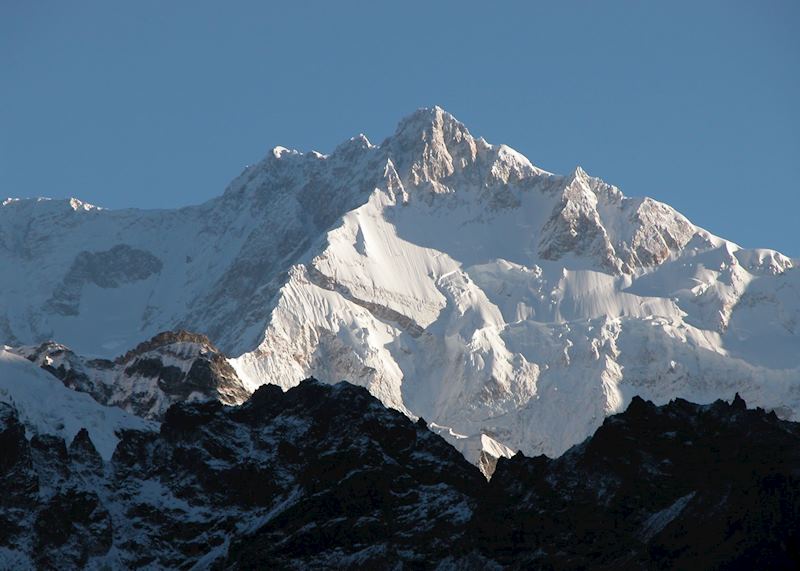
There’s no airport, so you need to drive from Bagdogra in West Bengal along bumpy roads that slowly wind up past tea plantations until the terrain becomes wilder.
The capital of Sikkim, Gangtok, is perched on a hilltop — in fact, that’s what Gangtok means — with nothing between it and the Himalaya (aside from the clouds). If you’re not satisfied with the mountain views at street level, you can visit Enchey Monastery above the city.
I then headed west to the tiny town of Pelling, right on Kangchenjunga’s doorstep. Arriving on a foggy day, I couldn’t even see across the road clearly. At 5am the next morning I was woken by a call: an urgent plea to look out of the window. The clouds had cleared and the south face of Kangchenjunga was there, looming above me.
For leisurely walks: The Western Ghats by Alex
Modestly letting the Himalaya take the limelight, the Western Ghats mountain range still runs an impressive 1,600 km (990 miles) from Gujarat to Kerala in south India. These rolling ridges and valleys are habitat to so many species of plants, insects and birds that UNESCO has designated them one of just eight ‘biodiversity hotspots’ worldwide. As well as some excellent wildlife spotting, there are walking trails, cycle routes and organic farms to explore.

I stayed in Sultan’s Battery, a town in the south of the range, at Amaryllis, a family-owned mountainside boutique hotel that overlooks the Karapuzha Reservoir below. From here, you can lie back and enjoy the views — at sunset the sky often glows pastel pink.
Days can be spent walking or hiking: the family at Amaryllis will provide you with a guide or a hand-drawn map. The surrounding foothills are a patchwork of coffee and nutmeg plantations, while higher up you come to thick forest interspersed with hunks of limestone. The best views are from Chembra Peak, which sits proudly on the skyline. You need permission from the local forest office to climb the peak, a relatively easy three-hour ascent.
Cruising
For tropical scenery: A houseboat in Kerala’s backwaters by Sophie
If you have visited north India, Kerala will feel like a languid foreigner with an unhurried attitude to life that would rival the Caribbean.
Traditional rice barges have been converted into one-bedroom houseboats from which you can cruise Kerala’s network of lagoons, rivers and canals. You can take a daytime cruise or, for the ultimate experience, stay on board for a night or two. I boarded my boat in the coastal city of Alleppey, and we headed straight out onto Membran Lake.

As we tracked into the smaller waterways, fishermen were gathering their nets and local people were coming down to the river to do their washing. If you opt for a two-night stay, you have the option to paddle a little dugout canoe into some of the narrow waterways that run through coconut and spice plantations, where everything is bathed in a green light.
You have your own captain as well as a couple of crew, who spend most of their time fishing at the back of the boat — whatever they haul in will be your lunch (I enjoyed some fat river prawns).
In the evening a huge platter of food, including a large pomfret fish caught a few hours before, is served on banana leaves. You spend the night on board before disembarking back in Alleppey.
For a voyage: cruise the Hugli River by Andy
A distributary of the Ganges, the Hugli River begins at the township of Farakka, close to the Bangladesh border, and ends in the Bay of Bengal just south of Calcutta. As the Hugli courses its way toward the Indian Ocean, it passes ghats, temples, farms and rural villages. On a seven-night cruise you can journey the Hugli’s length and see the daily life that revolves around it. The river is narrow, so you can always see both banks, which are often busy with villagers washing their clothes or bathing cattle.
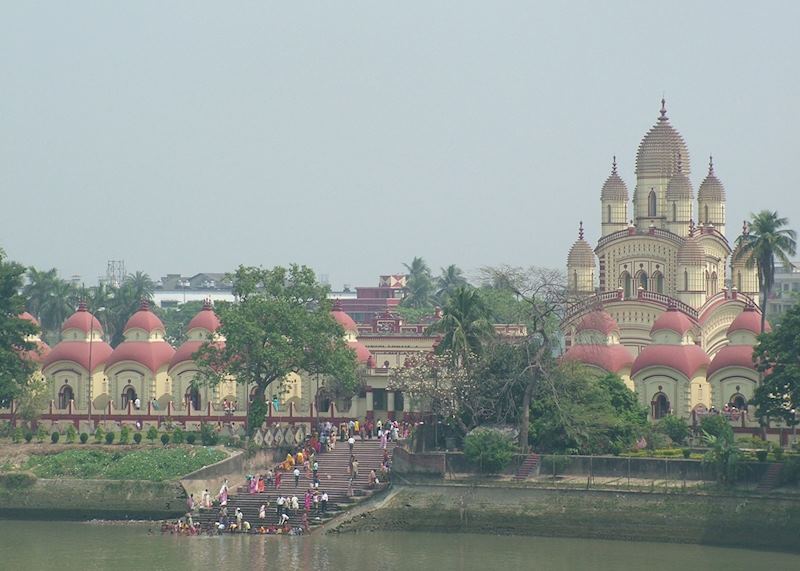
I journeyed upriver from Calcutta on the Assam Bengal Navigation ship the Sukapha, one of only a handful of boats cruising the Hugli. Sleeping 24 guests, it’s a simple, intimate ship with a lounge and an open-top deck furnished with lounge chairs.
The Sukapha only cruises in the daytime. I’d get up about 6am and sit on the top deck to watch the local ferries crossing from shore to shore. Each evening, the next day’s itinerary was circulated — usually a couple of on-shore walking tours and an evening talk or documentary.
Disembarking at Farakka, you can catch the Shatabdi Express train back down to Calcutta, which takes about five hours.
Food
For home-cooked food: Dewalokam Homestay, Kerala by Sophie
India was one of the first countries to offer homestay experiences, as local families looked for ways of boosting their income, and it’s an idea that’s never looked back. Part of the reason and, the highlight for me, is the home-cooked food your hosts will serve. I’d argue that the combination of fresh vegetables, coconut milk and seafood that goes into Keralan cuisine is difficult to beat, and there’s usually the opportunity to see how it’s cooked.
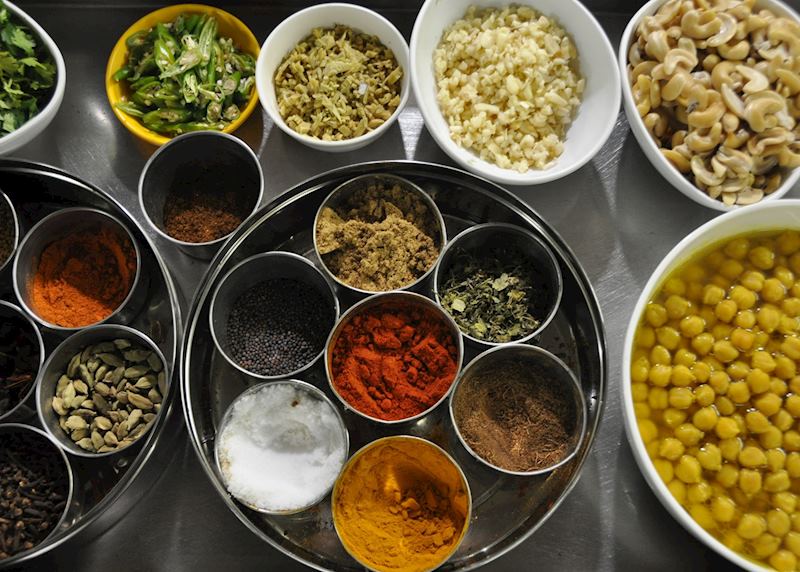
The food is so good at Dewalokam Homestay that, after many requests, owners Jose and Sinta have produced a cookbook. Set in a spice plantation in the Keralan countryside, their family home has 11 air-conditioned rooms for guests. Jose regularly runs tours of their organic farm, where you can help with the harvest or planting vegetables.
If you’re eager to be involved, you can also help to milk the cows, prepare the home-grown coffee beans or watch honey being extracted. Cooking lessons are a regular occurrence in the kitchen, where you might learn how to fry a dosa (crispy pancake) or balance the spices in a fish moilee (fish curry). Some recipes — curries particularly — demand more than 30 carefully prepared ingredients (and each household will have its own variation).
Mumbai by Andy
As one of India’s most populated cities, Mumbai needs to feed a lot of people. Street-food stalls fuel the workforce, families and friends come together in restaurants, and exclusive hotels and à la carte restaurants service India’s booming middle classes.
You can spend a whole day eating your way around Mumbai. I toured the city with my guide at dawn, just as the city was waking up. We joined the locals making their way to the Flora Fountain plaza, which was lined with street-food stalls cooking up breakfast. I tried vada pav, a deep-fried potato patty, and a bhaji the size of both hands topped with spicy pink tamarind sauce.

For lunch, I always try to squeeze into the Leopold Cafe. You might see a few backpackers hanging out there (Bollywood runners often come by looking for western extras), but the eaters are mostly locals meeting up for the chicken tikka masala. Big fans hum noisily above and the tables are crammed in, but you’re right in the hubbub of Mumbai.
Just down the road is the Taj Mahal Palace Hotel. The grand dame of Mumbai, this palatial property has a host of reputed restaurants. I head straight to the Sea Lounge, where you can enjoy an afternoon tea overlooking the water to the Gateway of India.
Start planning your trip to India
Start thinking about your experience. These itineraries are simply suggestions for how you could enjoy some of the same experiences as our specialists. They're just for inspiration, because your trip will be created around your particular tastes.
View All Tours in India